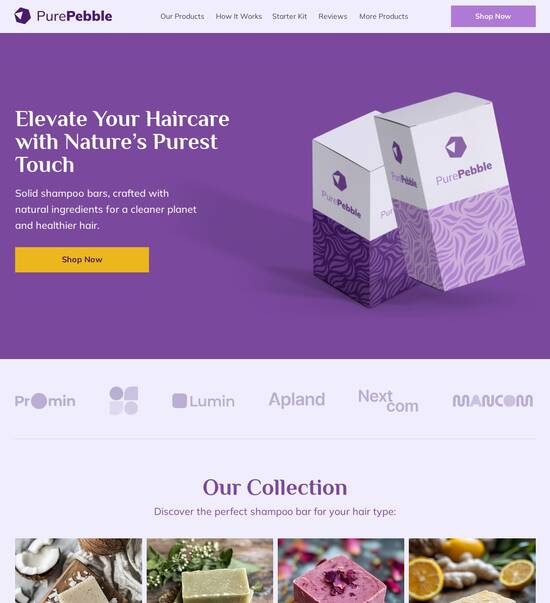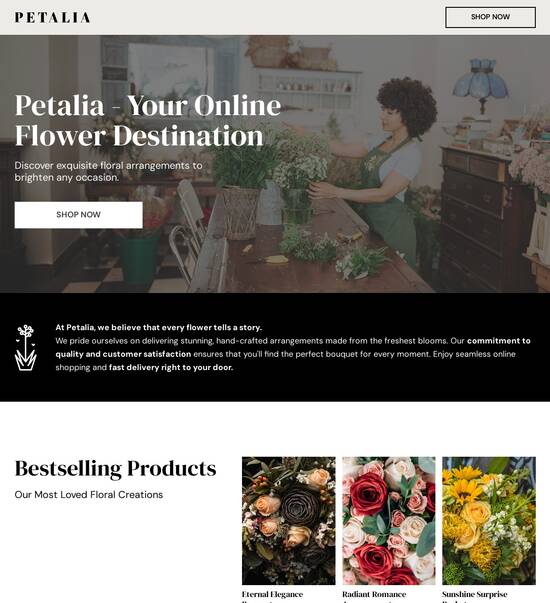
HTML/CSS optimized locations page template
Explore Similar TemplatesAbout template
Supercharge your locations page with HTML/CSS for outstanding performance! Learn more today.
Recommended templates

Easy to build without coding
With the intuitive drag-and-drop builder, anyone on your team can create high-converting pages without any knowledge of code or design. Make enhancements to your landing page with custom widgets using Javascript, HTML/CSS, or third-party scripts.

Multiple layouts for any industry and goal
Select from 500+ landing page layouts built to boost conversions across industry-specific scenarios. Customize them by adjusting fonts, adding images, and generating on-brand content with the AI assistant. Quickly scale with Instablocks® and Global Blocks that you can save, reuse, and update globally.

Loads fast and looks polished on any device
Every template is responsive, which means they present professionally on any device and load blazingly fast with our Thor Render Engine. You can also power them up with Google AMP technology to deliver an unparalleled mobile experience and drive higher conversions.

Robust analytics & experimentation
Get real-time updates and reporting across all your devices, showing the number of visitors, conversions, cost-per-visitor, and cost-per-lead. Launch AI-powered experiments, run A/B tests, and use heatmaps to analyze user behavior, then optimize your landing page to maximize conversions.







Easy to build without coding
With the intuitive drag-and-drop builder, anyone on your team can create high-converting pages without any knowledge of code or design. Make enhancements to your landing page with custom widgets using Javascript, HTML/CSS, or third-party scripts.
Multiple layouts for any industry and goal
Select from 500+ landing page layouts built to boost conversions across industry-specific scenarios. Customize them by adjusting fonts, adding images, and generating on-brand content with the AI assistant. Quickly scale with Instablocks® and Global Blocks that you can save, reuse, and update globally.
Loads fast and looks polished on any device
Every template is responsive, which means they present professionally on any device and load blazingly fast with our Thor Render Engine.
Robust analytics & experimentation
Get real-time updates and reporting across all your devices, showing the number of visitors, conversions, cost-per-visitor, and cost-per-lead. Launch AI-powered experiments, run A/B tests, and use heatmaps to analyze user behavior, then optimize your landing page to maximize conversions.
All the features you need to build lead-generating landing pages
Explore more featuresLearn how to build top-performing landing pages for any goal
FAQs
Leading the way in building high-performing landing pages





Introducing the company: why choose Instapage and its HTML/CSS optimized locations page template
When starting a marketing campaign, having a compelling and conversion-targeted website is crucial. Introducing your organization, with its mission, values, and achievements, plays a major role in building trust with potential customers and can help capture more visitors, keep them engaged, and ultimately convert them into customers. So, what's the most efficient way to develop a web page introducing your brand and vision? Instapage is the answer!
Our landing page platform offers more than 200 pre-designed layout templates, including the HTML/CSS optimized locations page template. Pick the one you like and easily adapt it per your business requirements in the drag-and-drop editor to make it get noticed and resonate with your target audience. Let's summarize the factors motivating to choose Instapage and its layout library:
- Design that speaks volumes. Created by expert designers, our layouts embody sophistication and functionality, guaranteeing your brand's first impression is indelible.
- AI-powered personalization. The AI-powered content generator helps easily write a copy that speaks right to your audience, enhancing relevance and engagement.
- Improvement in conversions. Thanks to the A/B testing feature and other SEO-optimization tools, you can examine how your page performs, analyze the metrics, and make the essential modifications to convert more.
Start using Instapage and build a strong foundation for your online presence. The platform gives you access to unparalleled customization, innovation, and integration capabilities, helping your brand get noticed and engage better with your audience. Sign up for a free trial now!
People also ask about HTML/CSS optimized locations page template
HTML/CSS optimized locations page template: A comprehensive guide
Understanding HTML/CSS optimized locations page templates
Locations page templates serve as crucial elements in web design, specifically tailored to showcase various locations a business serves. These templates help in creating user-friendly pages that facilitate easy access to information about different business locations, which can significantly enhance user experience. By optimizing these templates with HTML and CSS, designers ensure that the pages load quickly and display properly on all devices. Optimization is not merely about aesthetics; it influences the entire user journey, helping to retain visitors and convert them into customers.
The importance of HTML/CSS optimization can't be overstated. Efficient coding practices contribute to faster load times and better overall performance. Given that a large portion of online traffic comes from mobile users, responsive design practices in HTML and CSS ensure that locations pages not only look good but also function seamlessly across various screen sizes, ultimately improving user engagement.
Definition of locations page templates in web design.
Importance of HTML/CSS optimization for responsive and efficient web pages.
The building blocks of HTML and CSS
Understanding HTML is fundamental for anyone engaged in web design. HTML acts as the skeleton of a webpage, providing essential structure. The significance of each component increases when designing specific templates; location pages thrive on the correct hierarchy of information, which is facilitated by using key tags such as , , , and . Utilizing semantic tags enhances accessibility, allowing all users—including those relying on assistive technologies—to navigate the site effectively.
CSS offers the visual appeal, allowing designers to inventively style these HTML structures. It governs layout and aesthetics, enhancing user experience through attractive designs and usability. Key features of CSS such as media queries allow for responsive design, ensuring that pages reformat for different screen sizes. Additionally, flexbox and grid layout systems provide versatile methods for creating complex layouts without compromising responsiveness.
Core structure of HTML and key tags essential for location pages.
Role of CSS in visual styling and layout.
Integration techniques for optimized performance using HTML and CSS.
Essential features of an optimized locations page template
When designing a locations page template, user-centric design is paramount. This includes easy navigation, which helps visitors quickly find the information they're looking for. Navigation should be intuitive, incorporating clear menu options, breadcrumb trails, or a search function. Engaging visuals, like high-resolution images of the business locations, are also essential as they not only attract attention but provide context regarding the services offered at each location.
Incorporating functional components significantly enhances user experience. Integrating interactive maps, such as those provided by Google Maps, allows users to visualize their destination and obtain directions. Additionally, contact forms and strategically placed call-to-action buttons encourage visitors to engage further, providing crucial lead generation opportunities. By prioritizing these elements, businesses ensure they maximize the potential of their locations pages.
User-centric design elements enhancing navigation.
Functional components like maps, contact forms, and CTAs.
Mobile responsiveness for optimal viewing experiences.
Crafting an effective locations page
To create a successful locations page, following a structured setup process is essential. Initially, one should plan the page's content and structure meticulously. This planning phase may involve sketching rough layouts and deciding on the information hierarchy. Next, writing clean and semantic HTML markup is crucial. This ensures that the code is both easy to read and maintain while also benefiting search engine optimization.
The next step focuses on styling with CSS for both aesthetic appeal and optimal functionality. This includes choosing color schemes that align with the brand, employing typography that enhances readability, and ensuring spacing is well-balanced. After the foundational elements are addressed, incorporating interactive elements, like embedded Google Maps and responsive contact forms, completes the page's functionality. Finally, soliciting user feedback is imperative to refine the layout and ensure it meets the needs of your audience.
Planning page structure and content.
Writing clean and semantic HTML markup.
Styling with CSS for visual appeal and functionality.
Incorporating interactive elements like maps and forms.
Finalizing layout with user feedback.
Optimizing your locations page for SEO and performance
To ensure that your locations page is discoverable, implementing effective SEO strategies is vital. This begins with thorough keyword research to identify phrases that potential customers might use to find your services. By incorporating these keywords naturally in headings and throughout the content, you improve your visibility online. Moreover, it is essential to optimize metadata, including page titles and meta descriptions, as well as using alt text for images to enhance search engine results.
Performance optimization techniques also play a critical role. Minimizing load times should be a priority; this can be achieved by compressing images, removing unnecessary code, and leveraging modern formats such as SVG for graphics. Employing caching strategies and utilizing content delivery networks (CDNs) further improve page loading speeds, ensuring an efficient experience for users regardless of their location.
SEO strategies such as keyword research and metadata optimization.
Performance optimization techniques for faster load times.
Resources for learning and refining skills
Venturing into the realm of HTML and CSS requires a combination of theoretical knowledge and practical experience. Numerous online tutorials are available to help both beginners and advanced users enhance their skills. Platforms such as Codecademy, freeCodeCamp, and W3Schools offer structured learning paths, enabling students to delve into HTML and CSS at their own pace. Committing to a learning schedule while consistently applying learned skills in real-world scenarios can yield substantial progression.
In addition to tutorials, engaging in hands-on applications is an ideal way to test and solidify your knowledge. Sample projects can range from creating simple web pages to developing complete locations pages. By working on real-world projects, including optimizing an existing locations page, you gain insights that textbooks might not offer, ultimately preparing you for future challenges in web design.
Recommended online tutorials for various skill levels.
Ideas for practical exercises to reinforce HTML/CSS knowledge.
Challenges and common questions
Creating an optimized locations page is not without its challenges, particularly for beginners. Common issues include ensuring browser compatibility, maintaining responsiveness across devices, and properly implementing HTML/CSS best practices. Addressing these issues often involves utilizing resources like browser testing tools and validation services to troubleshoot specific challenges. For more complex problems, referring to community forums or reaching out to experienced designers can provide clarity.
Beyond troubleshooting, it's essential to overcome typical obstacles when designing locations pages. Many designers struggle with balancing functionality and aesthetics, which can significantly impact user experience. Employing a strategy that emphasizes user feedback and iterative design improves the overall quality of the final product, while also fostering an environment of continuous learning and improvement.
FAQs addressing common issues like browser compatibility.
Strategies to overcome typical design obstacles.
Case studies and real-world applications
Examining successful implementations of locations pages can provide invaluable insight. Brands that prioritize optimized locations page templates, such as large franchises, showcase best practices in user experience design. These pages often feature multi-locations, interactive elements, and cohesive branding, leading to higher engagement rates and conversions. Studying these examples can help aspiring designers recognize effective strategies and apply them to their own work.
Looking forward, the evolving digital landscape suggests trends in HTML/CSS page templates that align with advancements in technology. Increasingly, artificial intelligence and machine learning are becoming integrated into web design processes, offering smarter analytics and user personalization features that tailor experiences to the end-user. Keeping an eye on these future trends is essential for designers aiming to remain competitive in a constantly shifting online environment.
Analysis of successful brands utilizing optimized locations pages.
Future trends in HTML/CSS design fueled by tech advancements.
Metrics and testing for continued improvement
Tracking the performance of your optimized locations page is key to ongoing success. Setting up analytics tools like Google Analytics allows designers and marketers to monitor user interaction and behavior on the site. Key performance indicators (KPIs), such as bounce rates, time on page, and conversion rates, should be established as benchmarks for evaluating performance. Regularly reviewing these metrics uncovers insights into user engagement, allowing for data-driven enhancements.
Incorporating iterative testing approaches, including A/B testing, further identifies what elements work best for your audience. Gathering user feedback and analyzing behavior patterns create a robust cycle of continuous improvement. By focusing on these metrics and actively testing new ideas against established benchmarks, you maximize opportunities for user satisfaction and conversions.
Setting up analytics for precise performance tracking.
Using iterative testing methods to optimize user experiences.
Ready to skyrocket conversions?
Supercharge your ad campaigns with high-performing landing pages
Get started














